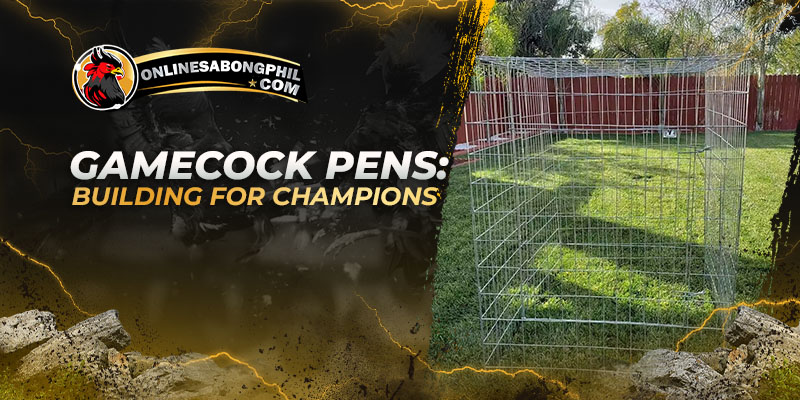Gamecock pens aren’t just a simple enclosure – they’re the foundation for raising and training these magnificent birds at their full potential. Bred for their fighting spirit, gamecocks demand specialized housing that unlocks peak performance while ensuring their safety and well-being. Investing in the right pen isn’t just an option; it’s a necessity for any dedicated Gamecock enthusiast.
What Are Gamecock Pens?
Gamecock pens are secure structures designed specifically for housing gamecocks. They protect the birds from predators, harsh weather conditions, and the potential injuries they might inflict on each other due to their naturally combative nature. These pens provide a controlled environment where gamecocks can safely exercise, feed, and undergo the conditioning necessary for their intended purpose.
Why Are Gamecock Pens Essential?
Gamecocks, bred for their fighting prowess, require specialized care to ensure their safety, health, and optimal performance. Gamecock pens play a crucial role in fulfilling these needs. Here’s a detailed look at why gamecock pens are so important:
Safety
- Gamecocks have a strong instinct to fight. Pens provide a secure environment that isolates them, preventing serious injuries or even death that could occur from uncontrolled fighting with other birds.
Health and hygiene
- Gamecock pens make it easier to maintain a clean environment. Regular cleaning of the pen helps prevent the build-up of droppings and parasites like mites, lice, and worms, all of which can significantly impact the birds’ health.
Conditioning
- Especially with fly pens, gamecocks have space to move, fly, and exercise their muscles. This controlled exercise helps build the strength, stamina, and agility needed for their intended purpose.
Breeding
- Breeding pens are designed specifically to facilitate safe and controlled mating. They often include nesting boxes to encourage hens to lay eggs and provide a secure space for incubation and rearing young chicks.
Types of Gamecock Pens
Gamecocks need their own specialized housing, and that’s where different types of pens come in! Let’s take a quick look at the most common options:
- Individual pens: These pens are designed to house a single gamecock. They are typically smaller in size and focus on providing the bird with enough space to move comfortably, turn around, and stretch its wings. Individual pens are essential for preventing fights and isolating birds during training or recovery periods.
- Fly pens: Fly pens are significantly larger enclosures designed to promote exercise and muscle development. They usually measure at least 10 feet by 10 feet by 6 feet tall, allowing the gamecocks to fly and practice the physical movements needed for competition. Fly pens help build endurance, strength, and agility.
- Breeding pens: Designed with a focus on reproduction, breeding pens are larger to accommodate a rooster, multiple hens, and nesting spaces. They include secure nesting boxes where hens can lay eggs in a safe, undisturbed environment. Breeding pens allow for controlled mating and a protected space for hatching and raising chicks.
Designing Your Ideal Gamecock Pen
The ideal Gamecock pen needs careful planning for optimal size, materials, and features. Here’s the breakdown:
Size considerations
- Individual pens: Minimum 4x4x4 feet for basic movement.
- Fly pens: At least 10x10x6 feet for exercise and flight.
- Breeding pens: Minimum 8×8 feet for a rooster, hens, and nests.
Materials
- Flooring: Concrete is durable but harsh; dirt or sand with shavings is softer but needs more upkeep.
- Walls: Wire mesh for ventilation; solid sides offer weather protection.
- Roofing: Metal or plastic with a slope for rain runoff.
Essential features
- Roosting bars: Smooth wood for comfort and leg strength.
- Feeders and waterers: Sturdy, waste-reducing designs.
- Predator protection: Strong wire mesh, partially buried.
Site selection
- Sunlight: Partial shade is ideal.
- Drainage: Avoid muddy areas.
- Accessibility: Easy to reach for care.
Foundation and flooring
- Concrete: Level base, pour, and finish.
- Gravel: Landscape fabric, then gravel layer.
- Natural: Clear debris, optional sand base, then wood shavings.
Framing and walls
- Frame: Wood or metal, pressure-treated wood lasts longer.
- Ventilation: Gaps or mesh for airflow.
Roofing
- Sloped: Metal or plastic for rain runoff.
Finishing touches
- Roosting bars: Install at appropriate height.
- Feeders and waterers: Secure inside pen.
- Dust bath (optional): Sand or diatomaceous earth helps control parasites.
Essential Equipment
- Feeders and waterers: Hanging/trough or automatic systems.
- Roosting bars: Smooth wood prevents injury.
- Nesting boxes (breeding pens): Comfortable and easily cleaned.
- Dust baths: Shallow pan with sand or diatomaceous earth.
FAQ
Can I build my own gamecock pen?
- Absolutely! With basic DIY skills and the right materials, building your own pen can be a rewarding and cost-effective option.
How much does it cost to build a Gamecock pen?
- The cost varies depending on size, materials, and whether you DIY or hire a builder. Simple pens can be built for a few hundred dollars, while larger, more elaborate setups can cost more.
Where can I find Gamecock pen plans?
- There are resources online offering free and paid Gamecock pen plans. Search on websites dedicated to gamefowl or poultry keeping.
How many Gamecocks can I keep in one pen?
- For individual pens, stick to one gamecock per pen. Fly pens and breeding pens can accommodate multiple birds, but temperament and space requirements must be considered to avoid overcrowding.
Conclusion
Gamecock pens are essential for anyone raising and training these birds. By following this guide, you’ll create pens that keep your gamecocks safe, healthy, and ready to perform. Remember, responsible ownership means prioritizing their well-being – investing in good pens, providing proper care, and ensuring their health. Building the perfect pen is a rewarding project for any Gamecock enthusiast, and the right knowledge ensures both your birds and your efforts will thrive.
Visit us at Onlinesabongphil.com for more guides and tips!



